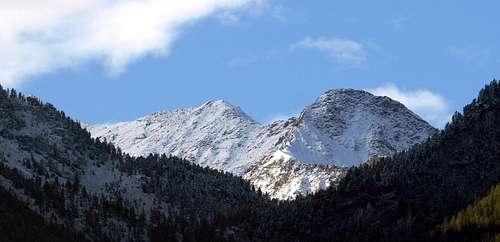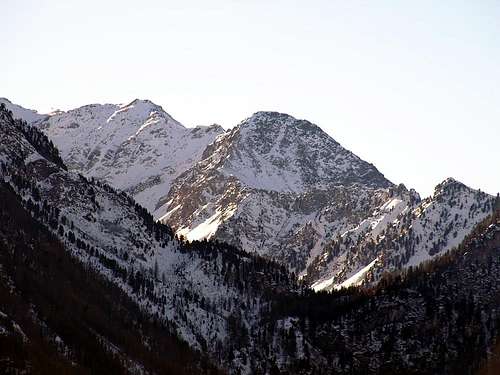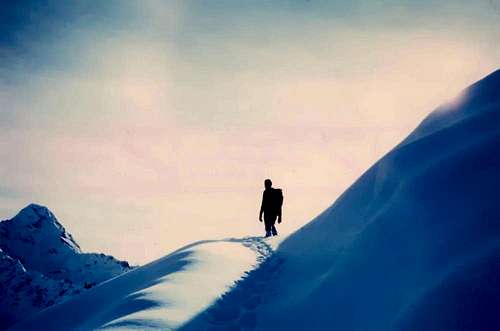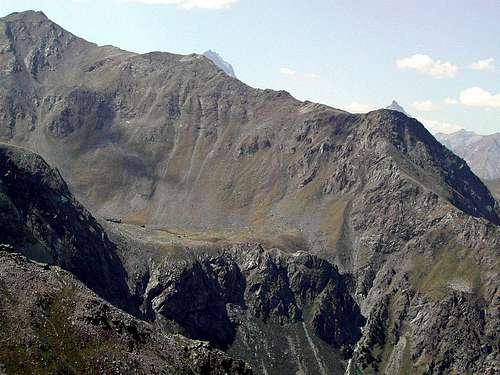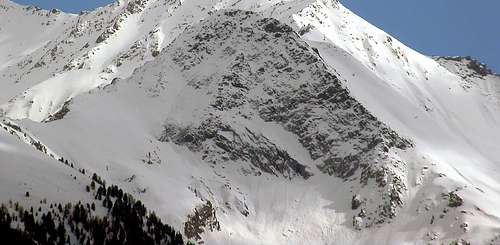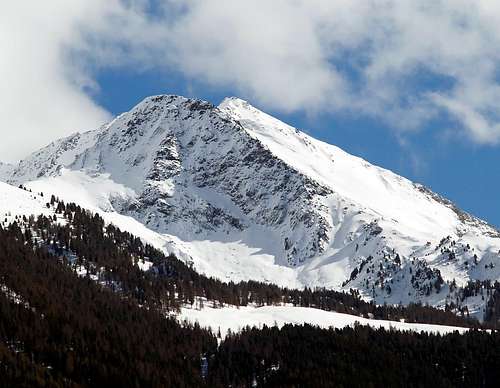-
 9682 Hits
9682 Hits
-
 89.77% Score
89.77% Score
-
 30 Votes
30 Votes
|
|
Mountain/Rock |
|---|---|
|
|
45.66810°N / 7.33668°E |
|
|
Mountaineering |
|
|
9249 ft / 2819 m |
|
|
Overview
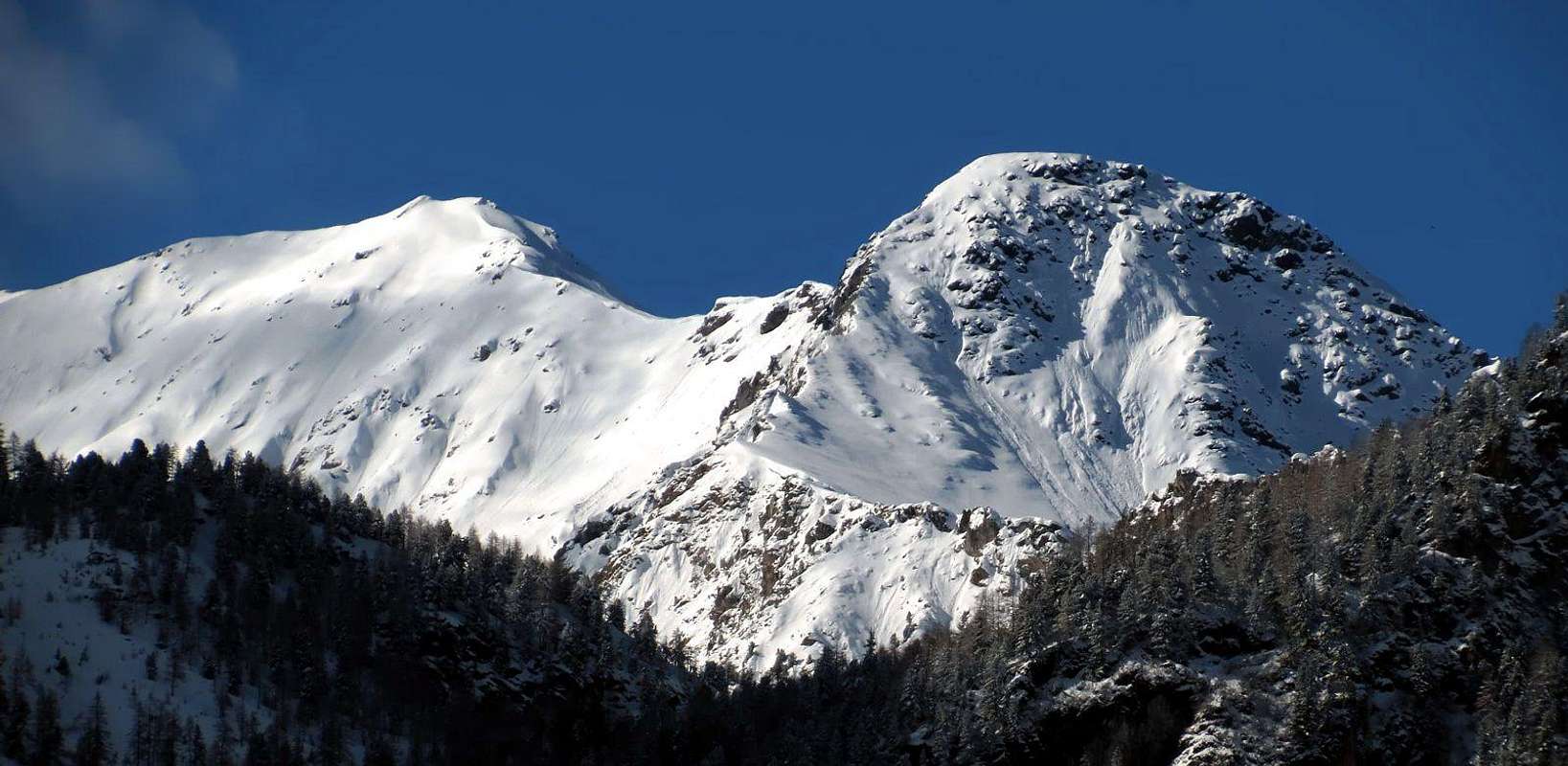
Appare alla vista dal Lago di Chamolé (2.311 m) come un massiccio e compatto testone grigiastro; dalla cima ampia e a forma di conca. In vetta si trova una croce metallica ben visibile dal basso. Dei suoi versanti il più scosceso è quello settentrionale che con una paretina di rocce rotte va a cadere sulla pietraia antistante il lago. La cima è molto frequentata a scopo panoramico con viste eccezionali sulla Grivola, Emilius, Garin e sulle Alpi Graie e Pennine. Anticamente era anche conosciuta come Auille Nera. Questa montagna é formata da tre creste con altrettanti versanti: oltre al primo del quale abbiamo detto, altri due scendono verso Oriente al di sopra del Vallone di Arbolle (2.500 m) composto da ripide rocce frammiste a strati erbosi e verso il Plan de l'Eyve (2.532 m) nell'opposta direzione. Le creste, in numero di tre, sono rivolte a Sud collegando la montagna con il Mont Bellefaçe (2.970 m), a Nordest sopra il Colle di Chamolé (2.641 m) ed a Nordovest in direzione della Stazione di arrivo della Seggiovia Pila Chamolé (2.311 m). Lungo le ultime due creste salgono le due "Vie Normali", generalmente percorse; la prima sale dal Lago di Chamolé (2.325 m) al suddetto colle per poi procedere sotto la cresta sulla quale ritorna nella parte finale, mentre la seconda o "Via degli Alpini" sale sotto la Cresta Nordovest ma decisamente più spostata verso il meno ripido Versante Nordovest. Sulla medesima era stata attrezzata una via con alcune corde, peraltro non necessarie essendo il percorso facile e poco esposto se non in alcuni brevi tratti, che nel tempo sono andate in rovina oppure semplicemente asportate. Questo itinerario é più sicuro di quello che sale dal Colle di Chamolé, anche se però meno frequentato perché meno conosciuto e fuori dalla rotta che conduce al Rifugio di Arbolle (2.516 m). In genere vengono percorse entrambe con quella che sale dal Colle di Chamolé segnalata come via per la vicina Punta della Valletta (3.090 m). Bisogna tenere ben presente che durante lo inverno, in presenza di eccessiva neve, entrambe le salite diventano alquanto pericolose; infatti sul Versante Nordovest scende regolarmente una valanga che si abbatte sopra le sottostanti piste di sci, mentre sul lato opposto il pericolo viene dalla discesa verso il Vallone di Arbolle. Infatti nel primo tratto, subito al di sotto del colle, risulta molto facile provocare il distacco della medesima. Belle viste su quasi tutta la Valle di Aosta, soltanto limitate ad Est dal trio di piramidi Monte Emilius, Punta Rossa e Pic Garin, mentre a Sud il panorama é occluso dalla Punta della Valletta. Grandi colpi d'occhio, comunque, sulla vicina Grivola.
First ascents
- First on the summit: Unknown.
- First in winter: Osvaldo Cardellina, Corrado Covi, Edy Covi, Camillo Roberto Ferronato, Giuseppe Lamazzi and Armando Poli, (Dec 30th, 1977).
- NE Crest (Standard Route): Unknown.
- N Wall (left route): Amilcare Crétier and Lucine Salval, (1925).
- N Wall (central route): Osvaldo Cardellina and Dario Sergio Cardellina, (Jul 29th, 1966).
- N Wall (right route): Osvaldo Cardellina and Ilario Antonio Garzotto, (Sep 22th, 1967).
- N Wall (extreme right route) and NW Ridge: Osvaldo Cardellina, lone (Aug 31th, 2004).
- NW Ridge: Ilario Antonio Garzotto and Osvaldo Cardellina, (May 27th, 1967).
Getting There
BY CAR:- From Torino, Milano, etc: Motorway A5. Exit at Aosta Est.
- From Switzerland: through the Grand Saint Bernard Tunnel or the namesake Pass.
- From France: through Mont Blanc Tunnel or Petit Saint Bernard Pass. It isn't necessary to take Motorway A5: you can drive on SS.26, in the direction of Aosta.
BY PLANE:
- Aeroporto "Corrado Gex"; Saint Christophe (Aosta).
Approaches
Approach A from Pila Resort: (2.325m) on foot through the various paths n° 19/19A/19B, passing respectively to the Alpage of Chamolé (2.532m; fountain), also towards the Bois (Wood) Chanté, going up directly into a small walloon to Chamolé Lake (2.325m). Or by a chairlift, and the homonymous pass above (2.641m). Wherefrom the Normal Route (Northeast Crest) starts also from the ones arriving here from Arbolle.Routes
Via A climb with "traditional route" through Chamolé Pass and the Northeast Crest: This is definitely the way followed by more and more, but still something extra after the construction of the Shelter Arbolle in July 1998. Starting with the arrival of the Chair (2.311m) to quickly reach a wide path through the slight slope Chamolé Lake (2.325m ; yellow signs); from the junction with the trail to the Hills of Replan and Comboé Vallon climb down to the right (South) and with a long diagonal first, followed by numerous large hairpin bends, reach Chamolé Pass (2.641m; 0h'50), real door entrance to the Vallon of Arbolle, lakes and shelter. Always a yellow sign points the way to the Tip of the Valletta (+ 3.090m) on the right; follow these directions and on a small track begin the ascent to below the edge of the Northeast Crest (this can be traversed in steps of I°/II°, exposed to Southeast) until the same, via a short crossing, is port more on the Northeast Slope. Go up broken rocks and debris and then with a few small steps on some narrow arrive on the same ridge where the trail becomes more evident with exposure from the same side; in short it out on the vast grassy plateau immediately to the left of the Cross of Summit (E/F; 0h'30; total 1h'30 from the start; 3h'00/3h'30 from Pila).Via B con salita per la Paretina Nord: Il versante erboso Nord-nordest è separato per mezzo di una ripida costola di rocce rotte da una paretina rivolta più a Nord, alta poco più di 280 metri. Dal lago salire la ripida pietraia che porta alla base della parete; attaccare per una placca sottostante una cengia ad arco e percorrerla verso sinistra (Est) prendendo il filo dello sperone che direttamente con passaggi divertenti, porta alla Vetta. Sulla medesima parete esistono altre vie che percorrono il settore di destra, il canale centrale, alcune varianti di base ed un'ultima via, la prima ad essere stata realizzata dal famoso Amilcare Crétier con Lucine Salval nell'estate del 1925, che sale ad Est del pilastrino centrale, quasi sul Versante Nord-nordest. Infine, per poi attraversare e concludere per mezzo dello stesso (EE/A; da F+ a PD+, a seconda della via scelta; da 2h'15 a 3h'00).
Route C rise for the Northwest Slope ("Via degli Alpini") or to the Northwest Ridge: a third way, an alternative to A, up along the Northwest Slope, just below the crest of the same, that goes on the left. Always starting from the Station of Chair lift, climb directly to the South through a small and very steep path numbered 19B, which reaches a rocky headland forest-followed by a depression (2.450m); reach a second altitude (2.484m) neighbor a structure of the lifts of white color. From this point the trail, which is getting smaller and subsequently less obvious moves away from the ridge into the Northwest bringing more open slope until you reach a large grassy saddle South of the Summit. With this and with the direction to the North in a short time you can reach the same (E/F; 1h'15/1h'30 Station; 3h'00/3h'15 from Pila Resort). Alternatively, if you want to climb, carry much of the property on the Northwest Edge of the ridge and follow the same steps with the possibility of changing to a plate blackish just just below the Top; go with fun climbing (III°/III°+), or around the same immediately below to South (from F+ to AD-, according to the passages performed; from 2h'00 to 2h'30 from the arrival of Station).
Via C con salita per il Versante Nordovest ("Via degli Alpini") o per la Cresta Nordovest: una terza via, alternativa alla A, sale lungo il Versante Nordovest, subito al di sotto della identica cresta, che la accompagna sulla sinistra. Sempre partendo dalla Stazione della Seggiovia, si sale direttamente verso Mezzogiorno tramite un piccolo ed alquanto ripido sentiero numerato 19B, che raggiunge un promontorio boschivo-roccioso seguito da un avvallamento (2.450 m); raggiungere un secondo in altitudine 2.484 m) presso una struttura degli impianti da sci di colore bianco. Da questo punto il sentiero, che diventa sempre più piccolo ed in seguito meno evidente, si allontana dalla Cresta Nordovest portandosi in più aperto pendio fino a raggiungere una vasta sella erbosa a Sud della Sommità. Tramite questo e con direzione a Nord in breve tempo si raggiunge la medesima (E/F; 1h'15/1h'30 dalla Stazione; 3h'00/3h'15 dal parcheggio di Pila). In alternativa, volendo arrampicare, dalla struttura portarsi decisamente sul filo della Cresta Nordovest e seguire lo stesso con possibilità di variare i passaggi fino ad una placca nerastra appena subito sotto la Sommità; salire con divertente arrampicata (III°/III°+), oppure aggirare la medesima subito al di sotto a Sud (da F+ a AD-, a seconda dei passaggi eseguiti; da 2h'00 a 2h'30 dall'arrivo della Seggiovia).
Equipment for the Route
Standard mountaineering equipment.
Difficulty
- Normal Routes: Easy anf for Experienced Hikers F.
- N Wall: PD+ (low difficult) passages of I - II and II+ (UIAA).
- L'itinerario delle Via normali è da considerarsi F/EE.
- Per la Parete Nord PD+ passaggi di I – II – II+.
Campings
Remember that free camping is forbidden (except for emergency reasons, over 2.500m, from darkness until dawn).Mountain Condition
- Meteo: you can find all the needed informations at the official site of the Valle d'Aosta Region:
- Valle d'Aosta Meteo
Webcam
- WEBCAM on Aosta Valley:
- Webcam
Books and Maps
BOOKS:- "Guida del Monte Emilius", di Osvaldo Cardellina Editore in collaborazione con il Club Alpino Italiano Sezione di Aosta, Dicembre 1978.
- "Guida dei Monti d'Italia – Emilius Rosa dei Banchi Parco del Mont Avic" di Giulio Berutto e Lino Fornelli - Club Alpino Italiano/Touring Club Italiano, Marzo 2005.
- "Guida delle Alpi Occidentali" di Giovanni Bobba e Luigi Vaccarone C.A.I. Sezione di Torino Volume II (parte II), 25 Maggio 1896.
- "80 itinerari di Escursionismo Alpinismo e Sci Alpinismo in Valle d'Aosta", di Osvaldo Cardellina, Ed. Musumeci, Giugno 1977 (in Italian); seconda Ed. Luglio 1981; terza Ed. Luglio 1984; (in French), prima Ed. Febbraio 1978; seconda Ed. Marzo 1980.
- "Diari Alpinistici" di Osvaldo Cardellina e Indice Generale accompagnato da Schedario Relazioni Ascensioni 1964-2019 (inediti).
- Kompass "Gran Paradiso Valle d'Aosta Sentieri e Rifugi" Carta turistica 1:50.000.
- L'Escursionista "Conca di Aosta-Pila-Monte Emilius" Carta dei sentieri (n° 4) 1:25.000.
- Hapax "Les Sentiers Comunità Montana Monte Emilius", Luglio 2000 1:25.000.
- Enrico Editore Ivrea-Aosta "Gruppo del Gran Paradiso" 1:50.000.
- I.G.C. Istituto Geografico Centrale, Torino "Carta delle Passeggiate ed Escursioni in V.D.A. Conca di Pila-Gressan, 1:20.000.
Important Information
- REGIONE AUTONOMA VALLE D'AOSTA the official site.
- FONDAZIONE MONTAGNA SICURA Villa Cameron, località Villard de la Palud n° 1 Courmayeur (AO) Tel: 39 0165 897602 - Fax: 39 0165 897647.
- A.I.NE.VA. (Associazione Interregionale Neve e Valanghe).
Useful numbers
- Protezione Civile Valdostana località Aeroporto n° 7/A Saint Christophe (Ao) Tel. 0165-238222.
- Bollettino Valanghe Tel. 0165-776300.
- Bollettino Meteo Tel. 0165-44113.
- Unità Operativa di Soccorso Sanitario Tel. 118.


